Halloween Extravaganza: Jude’s Horror Comics and Manga Recommendations
It’s time for another Halloween Extravaganza, and to start us off I’ll be discussing these hair-raising, bloodcurdling, tongue twisting tales of terror to get you in the mood for Halloweenus.
Here’s a list of some recommendations for different horror comics I’ve personally read and experienced. Keep in mind I’ll only be mentioning comics I haven’t yet reviewed and recapped on Point Horror. So comics like Scary Godmother and Mermaid Saga won’t be discussed.
This was initially going to be longer, but I was having difficulty focusing on adding more titles. I’m considering doing a follow-up post in December for the sake of holiday shopping options.
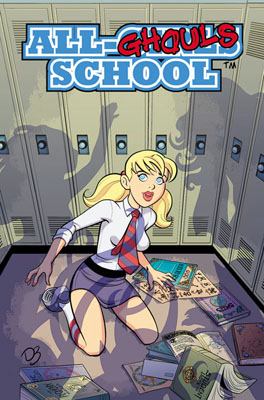
All-Ghouls School by Marc Sumerak and David Bryant
No, I’m not talking about “Scooby-Doo and the Ghoul School,” but close!
“All-Ghouls School” is a charming OGN published by IDW some years back. It tells the story of Becca Norman, a perfectly average young woman at the top of the social food chain in her own school. All that comes crashing down when her supposed friends use Becca as a scapegoat in a big cheating fiasco.
Becca’s only salvation comes in the form of a summer school program which she must attend at the mega creepy Darkmoor Academy, a secluded private girls school many say is haunted. Becca has no idea how right those rumors are, because Darkmoor Academy is a school for monsters!
Now at the bottom of the pecking order, Becca’s forced to confront her own prejudices and the subjectivity of normalcy as she’s singled out for being a grotesque human. Her persecution is led by the school’s resident bad girl, Elle Diablo, and her gang of toadies. Even worse, Elle’s dad is the school principal. Oh did I mention they’re both devils?
Becca’s salvation comes in the form of Wendy Olfman, the only other human girl at Darkmoor. Or is she? Together with Wendy’s friends Francesca Stein, Nightmaria Boogey, and Jacqueline Hyde, Becca manages to navigate this strange new world she finds herself in.
While Becca gains new friends and questions her old ones, she helps these horror outcasts stand up to their tormentors. Too bad Elle’s willing to stoop to some pretty nasty lows to get rid of Becca in a scheme that might actually destroy Darkmoor Academy.
“All-Ghouls School” is honestly a lot more fun than it should be. The names are all ridiculous puns but they’re endearing ones, and kudos to the creative for making the girls look like actual monsters who are still teenagers.

My personal favorite is minor character Christine, implied to be the niece of the Phantom of the Opera.

Batman: Red Rain Trilogy by Doug Moench and Kelley Jones
Moench and Jones were one of the essential Batman creative teams of the 1990s, alongside Alan Grant and the late Norm Breyfogle as well as Jeph Loeb and Tim Sale. It was Jones whose style captured the influence of the Tim Burton movies, creating a very Gothic looking Gotham City and a sort of warped, unsettling feel in most of the characters.
The Red Rain trilogy was a series of three Elseworlds graphic novels that ran on the simple premise of “What if Batman became a vampire?” Something which, surprisingly, had not really been done before. The three books in the original series comprised of:
- Batman & Dracula: Red Rain – The Dark Knight goes up against the Prince of Darkness himself and, aided by Dracula’s former lover, sets out to vanquish the legendary vampire.
- Batman: Bloodstorm – Batman struggles to grow accustomed to his new vampiric abilities and is having increasing difficulty in controlling his thirst for blood. Meanwhile, the Joker reemerges and takes control of Dracula’s underlings while Selina Kyle is transformed into a werecat.
- Batman: Crimson Mist – Batman has lost whatever semblance of humanity he held onto when an attempt to kill him goes wrong in every sense possible. Embracing his blood lust Batman slaughters most of Gotham City’s costumed criminals, forcing the survivors to team up with Commissioner Gordon and Alfred Pennyworth to stop him.
In my opinion, the first two books in the trilogy are probably the strongest while “Crimson Mist” feels like something of an afterthought. That said, it makes more sense to read the books altogether instead of as separate entities. This is probably why DC started publishing them together in trade paperback form.
These were among the most versatile of DC’s Elseworlds books to the point the setting has been repeatedly visited by other authors. In the mid 2000s, the Red Rain universe was established as part of the new 52 Multiverse under the designation “Earth-43.” DC’s 2007 Halloween special and the “Search for Ray Palmer” miniseries both had stories about this universe, only Batman’s death in “Crimson Mist” appears to have been undone.
Even Grant Morrison was willing to acknowledge Earth-43’s status, but went as far to clarify in “The Multiversity Guidebook” that this was an entire vampire Earth and implied Batman had somehow converted everyone in the Justice League. Thankfully, the Blood League gets neutralized when a spellcaster from another world makes them crave caffeine instead of blood.

Bizenghast by M. Alice LeGrow
One of many OEL (Original English Language) manga published by Tokyopop in the 2000s, Bizenghast is probably the most versatile, running at eight volumes and continued through self published editions by Mizz LeGrow (who is fucking awesome BTW).
Dinah Wherever has got problems. By which I mean she can see ghosts, and not friendly ghosts. She’s frequently accosted by the many spirits who haunt her home, which used to be a hospital and later an all boys school before it burned down. The worst of these spirits is the dreadful Addy Clark, a woman who supposedly set the fire that destroyed St. Lyman’s School for Boys and murdered several children. Dinah’s aunt and doctor both think she’s mentally ill, though her aunt is starting to doubt that it’s all in Dinah’s head.
The only person Dinah can turn to for comfort is her best friend Vincent Monroe. One day, Vincent sneaks Dinah out to go biking around the woods in their hometown of Bizenghast, when they come across a large, church-like structure Vincent swears wasn’t there before. The two briefly explore inside and discover it’s like a mausoleum, but then Dinah presses a button and out pops a contract… with her signature at the bottom.
That’s when Dinah meets the spider-like Bali-Lali, who informs Dinah she is now OWNED by the Sunken Mausoleum and must do work for them every night. Dinah must enter the dreams of the dead and help them settle their unfinished business so they can move on. Because if she doesn’t, Dinah will die.
Now you’re probably thinking this is an episodic “Free different spirit every night” type of thing, and it kind of starts out as such. The first few volumes mainly focus on Dinah and Vincent entering the dreams of different ghosts and helping them settle whatever is keeping them restless. Gradually the plot begins to focus on Dinah’s growth as a person and the ongoing mystery of Bizenghast’s dark secrets. The first volume alone is a good example of the former, because by the end Dinah’s offered the option of switching her contract to Vincent (who is more than willing to take it from her) but she decides no and wishes to follow this through because she wants to stop being so afraid of everything.
Besides Dinah and Vincent there are the Tower Guards, servants of the Sunken Mausoleum who are essentially “Unlocked” with every ten ghosts freed. There’s Edaniel, Edrear, Eniri, and Elala. Edaniel is, pretty much, the funniest character in the entire series. He usually takes the form of a green, cat-like creature with a permanent grinning face and likes to espouse his hatred for communism while breaking the fourth wall.

I don’t want to say too much about the other guards because I don’t want to spoil the fun.
The other main draw to this is all due to Marty LeGrow’s writing and artwork. Her costume designs are ingenious and so are many of the ghosts found in the Mausoleum; my personal favorite will always be the first, Cagey. The attention to detail’s impeccable, as Mizz LeGrow switches effortlessly between drawing beautiful people and grotesque abominations. She must be commended for her dedication to this series and for focusing on properly finishing it. More people need to read these books.
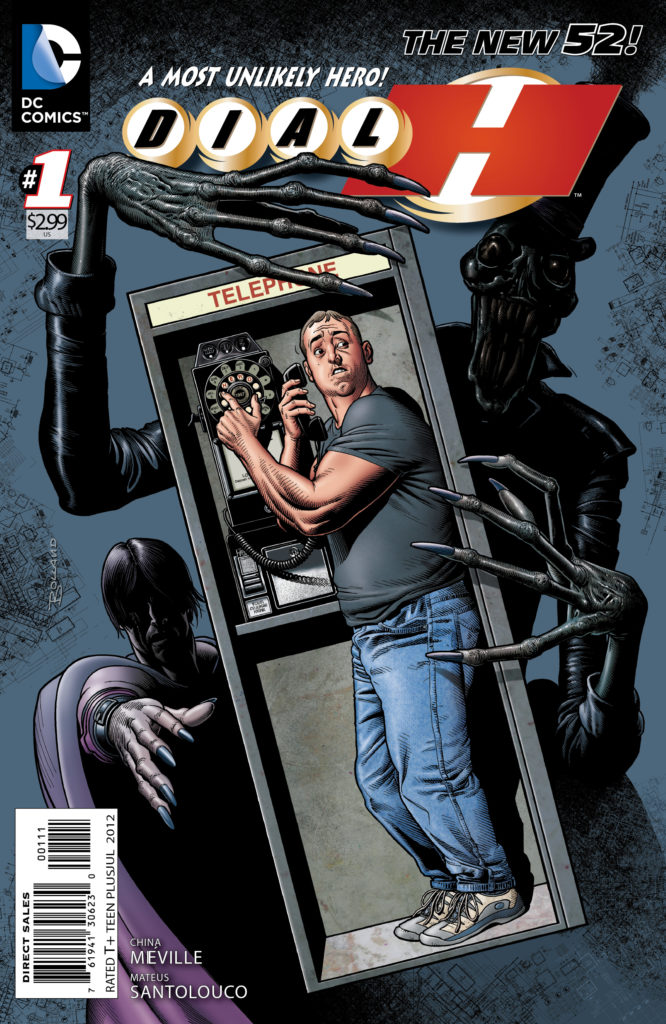
Dial H by China Mieville
In 2011, DC Comics had the notion to restart all their comics at #1 with brand new creative teams as a fresh start from their dwindling sales. In theory this sounded like a good idea but the execution was horrible. DC scrapped their decades of continuity by erasing dozens of beloved characters while rewriting and whitewashing their still existing ones to such a degree they were unrecognizable. Wonder Woman became a bastard of Zeus and her Amazon sisters were a society of rapist/murderers, Superman complained about getting friendzoned, Barbara Gordon went back to being Batgirl while her time as Oracle vanished, Superboy was a sociopathic clone of Superman and Lois Lane’s evil son from the future, etc.
One of the only good things to come from “The New 52” was “Dial H.”
You’ve heard of “Ben 10,” right? The kid with an alien watch that lets him turn into a different alien? “Dial H for Hero” predated that by at least fifty years. The concept concerned a toy dial which allowed ordinary kid Robbie Reed to turn into a different superhero just by dialing the words “H-E-R-O.” Readers got to send in their ideas for superheroes and villains for every story. Sci-fi author Harlan Ellison, of “I Have No Mouth And I Must Scream,” even got to send in a character during the 1980s.
China Mieville’s “Dial H” was a dark revisionist take on the mythos, but whereas the majority of the DCnU was dark (and boring), “Dial H” made it work by staying quirky, imaginative, and interesting. Maybe because Mieville utilized the past “Dial H”stories instead of regarding them as non-canon, and because he was following the example of the early 90s Vertigo/DC comics like “Doom Patrol,” “Black Orchid,” and “Sandman.”
The main character, Nelson Jent, was an out of work, overweight loser whose life went down the drain after his heart attack and his break up with his girlfriend. When Nelson sees his best friend Darren being attacked by a group of thugs, Nelson tries to dial 911 in an old phone booth, but instead is transformed into the bombastic Boy Chimney.

After that, Nelson finds himself immersed in an ancient conspiracy dating back to Babylon and faces the danger of completely losing himself every time he dials a new identity. Along the way he meets the mysterious and, quite frankly, awesome masked heroine Manteau, a fellow dialer who created a persona to act as her anchor to avoid losing herself in the better identities.
It’s part cosmic horror, part absurdist comedy, part heartbreaking drama, and it is amazing. It takes fucking style to create a version of Batman inspired by an open window and make him AWESOME. The series had some of the best character designs I’d seen from DC Comics in the last several years, and the fact it was cancelled at issue #16 is a travesty.
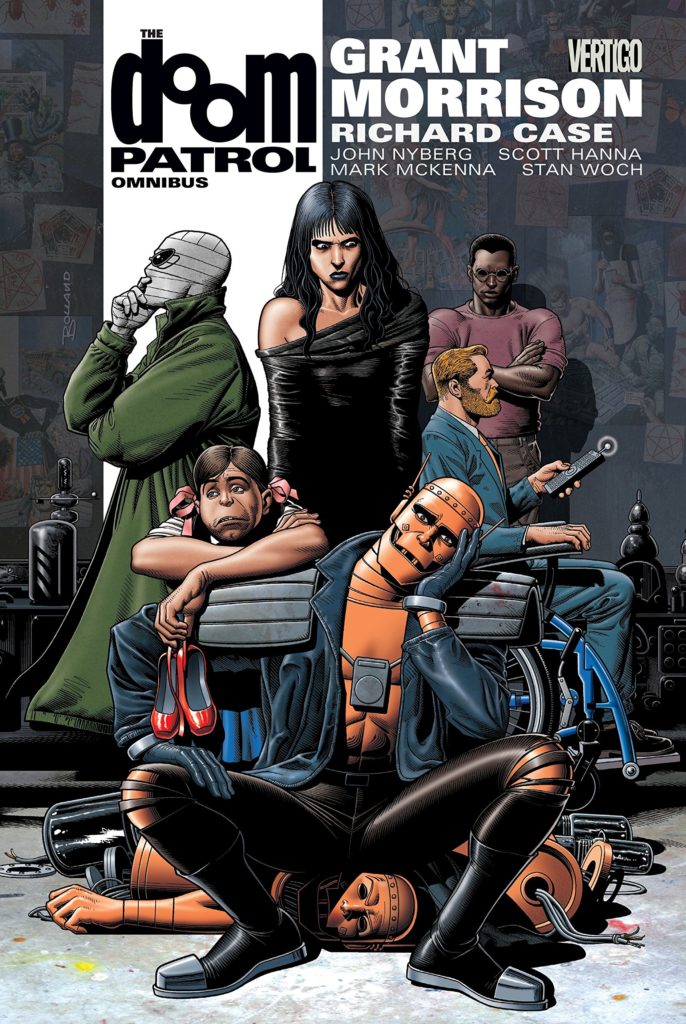
Doom Patrol by Grant Morrison and Richard Case
Once upon a time, DC Comics published a book about a team. They were a weird band of mismatched outcasts; a brain in a robotic body, a man possessed by a negative alien spirit, a woman who could shrink or grow any part of her body. Led by the wheelchair bound Chief, they were the Doom Patrol. And Marvel ripped them off to make the X-Men.
In the late 1980s, Grant Morrison was given the reins of the DP’s second ongoing series. His writing became an iconic definition of the Doom Patrol second only to the original series, because he brought back the weirdness for a new generation.
The line-up included the return of Cliff Steele a.k.a. Robotman, a brain trapped in a robot shell, haunted by a phantom body. Cliff is driven to despair from watching the Doom Patrol die several times while he continues to live. Alongside the return of Niles Caulder as the Chief, Morrison introduced the following:
- Rebis: Formerly Larry Trainor (Negative Man) and Dr. Eleanor Poole, the two individuals were combined into one by the Negative Spirit. A new being comprised of all three personalities and both genders, Rebis was an enigmatic, radioactive intersexed being who sported a snazzy looking coat and shades.
- Crazy Jane: One of the sixty three personalities inhabiting the body of Kay Challis, a young woman who suffered horrific sexual abuse by her father. Exposure to a weapon called a “Gene Bomb” granted each of the personalities superpowers and the ability to physically alter Jane’s body while in control. Some of her personalities include the iron clawed misandrist Black Annis, the raging nymphomaniac Scarlet Harlot, the psychic Lady Purple, the artistically empowered Hangman’s Beautiful Daughter, and the towering Sun Daddy.
- Dorothy Spinner: An unfortunate young girl born with a face like a monkey, Dorothy could psychically bring her imaginary friends to life… among other things. Dorothy spent most of her life living on a farm in Kansas, where she was ostracized by her peers and treated as a nuisance by her parents. In fact, her imaginary friends are the ones who taught her to read and write.
- Danny the Street: An honest to God, living street who is a genderqueer drag queen. Danny’s lined with hardware stores and gun shops decorated in frills and lace. He can manifest anywhere in the world, and he’s happy to offer shelter to anyone who needs it. Communicating through signs and window displays, Danny is the nicest person you could ever hope to meet.
This weird band of weirder individuals fought a number of grotesque and absurd creatures who, for all intents and purposes, should not exist. Things like parasite ideas, forgotten horsemen of the Apocalypse, the shadow of God, and a government agency that seeks to enslave the dead to enforce normality.
Morrison’s writing ranged from horrifying to bizarre to incomprehensible to funny and heartwarming. A lot of the time you have to wonder what drugs he was mixing to make this book happen, but the Doom Patrol strikes a chord in the weird outcast we all have inside of us.

Some of the scariest things to happen in this book stem from the realer aspects of the cast’s struggles. First you have Crazy Jane and her ongoing battle to deal with the abuse her father put her through when she was little. She’s internalized her trauma so deeply there’s a portion of her mind dubbed “The Well” that all her personalities are terrified of. It’s where one personality killed herself. And it’s where the “Daddy” personality lives. Inside Jane’s head, “Daddy” is a grotesque monster made of puzzle pieces and shit, yet still has Jane’s voice! Jane’s issues are NOT solved within a single issue, and even when she confronts the Daddy personality it remains lurking in her mind.
Then we have Dorothy Spinner and her issues. One of the earliest parts of Morrison’s run focused on Dorothy and how badly her first period fucked her up. No one bothered to prepare the young woman for puberty, and the event was so traumatic it permanently messed up her abilities. At that point, she decided she was too old for her family of imaginary friends and tried to kill them. With an imaginary gun, of course. Unfortunately, Dorothy’s power gets boosted one day and her imaginary friends come back to haunt her.
That isn’t to say Cliff and Rebis don’t have their problems. Cliff still has nightmares about the race car accident that destroyed his body, and Rebis’ body has been slowly rotting away because of the Negative Spirit. There’s an incredibly freaky sequence in one issue where they dream about Larry Trainor and Eleanor Poole, conjoined in one freakish body, screaming and trying to kill each other.
Of course if you think the heroes have it this bad, what about the villains? Morrison’s starter antagonists are the Scissormen, creatures with actual scissors for hands who come from the fictional land of Orqwith. They use their scissors to cut people out of reality, and in the case of one doctor, left half of him in the real world while he screamed “THEY’RE CUTTING OFF MY THUMBS!”
Other such frightening entities were the Cult of the Unwritten Book, a religion devoted to summoning the Anti-God in order to unmake creation. They’re a gaggle of mismatched abominations: kites made of human skin, disembodied mouths, children made eternally young through grotesque body modification. Then you had the Men from N.O.W.H.E.R.E., a government organization that has enslaved the dead by use of an entity called the Telephone Avatar. They seek to eradicate all weirdness, any original thought, to take control of the world.
But the worst Morrison and artist Richard Case came up with was the Candlemaker.
Oh, I could also tell you about the Brotherhood of Dada. But I’d rather let them speak for themselves.
That said, plenty about this series hasn’t aged well, particularly in regards to the portrayal of Crazy Jane’s mental health.
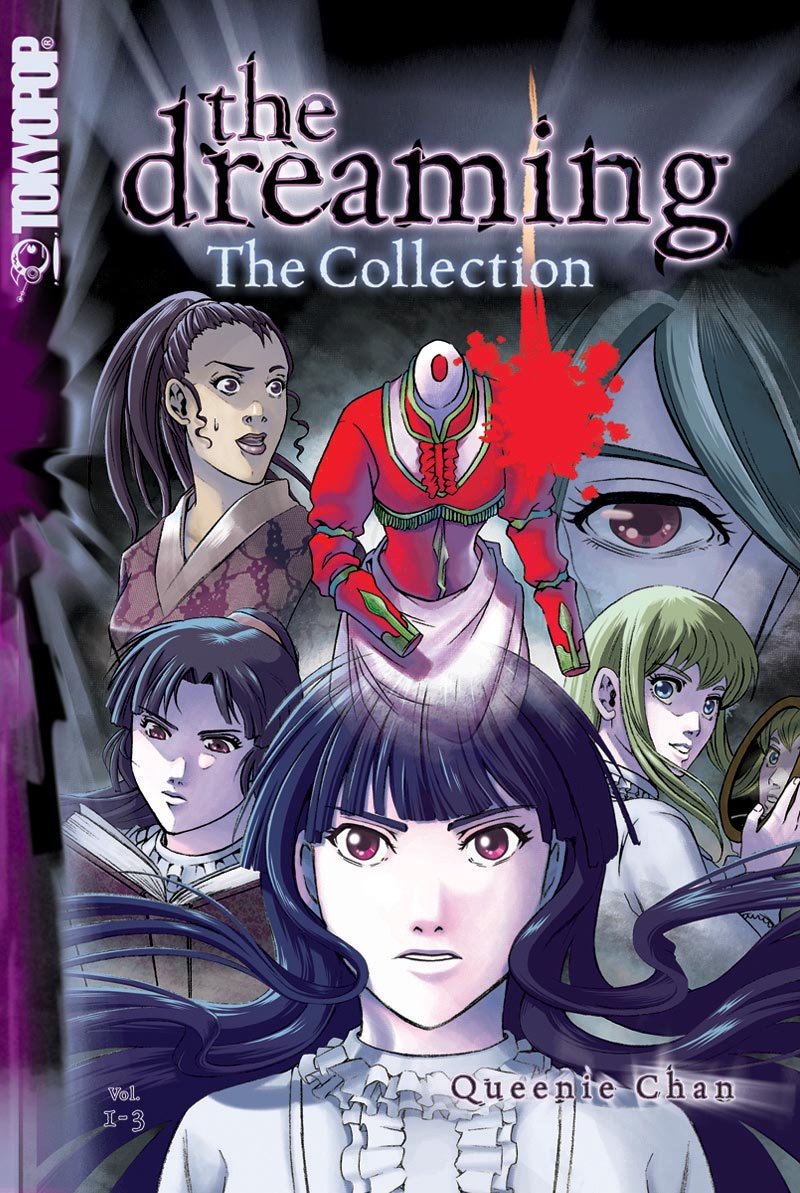
The Dreaming by Queenie Chan
Another of Tokyopop’s OEL manga, this one is three volumes, but unlike many of the OEL titles, was able to run to completion.
Inspired by the novel and film “Picnic at Hanging Rock,” “The Dreaming” takes place at Greenwich Private College, a private academy deep in the heart of the Australian bush. Twin sisters Jeanie and Amber have been enrolled thanks to their aunt Jessie Malkin, the headmistress. Yet when the two arrive, their aunt asks them not to tell anyone they’re twins. It seems the Vice Principal and actual owner of the school, Mrs. Skeener, is a superstitious old woman and has a problem with twins.
Introvert Amber already has her hang ups about the school and immediately feels something’s wrong, while the more outgoing Jeanie tries to get her sister to stop being so serious. It isn’t long before Jeanie realizes there IS something off about the place. Not counting how nasty Mrs. Skeener is, the school contains a series of bizarre paintings dating pre-1920s, all depicting young Victorian women doing everyday activities, like having tea parties and chasing after people with butcher knives. In every painting the same faceless woman skulks in the background.
The twins learn Greenwich has a history of students disappearing into the woods surrounding the school and are never seen again. Hell, the entire first class and the school’s founder vanished without a trace! As Jeanie and Amber start having disturbing nightmares, the SAME nightmares shared between them, one of their friends is the next to disappear… and that’s just the beginning.
Queenie Chan’s created a legitimately unnerving story about isolation and losing one’s self for the sake of survival. Like Marty LeGrow she excels at gorgeous outfits and grotesque expressions, though with Queenie Chan it’s all in the eyes.
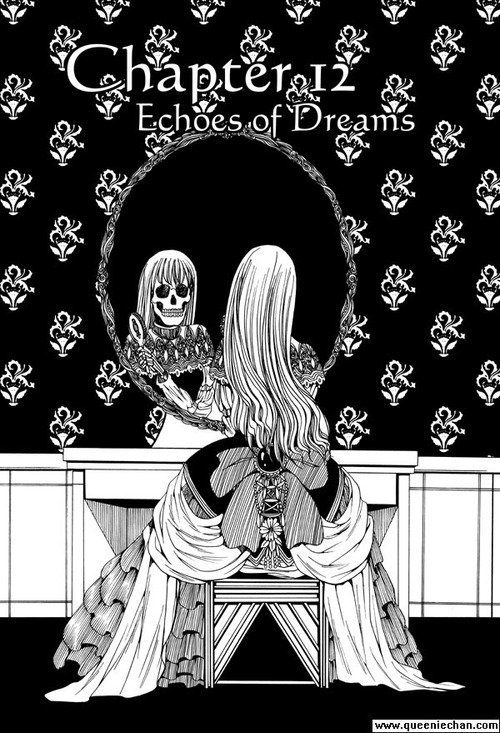
One highlight especially is the artwork used for every opening chapter page.
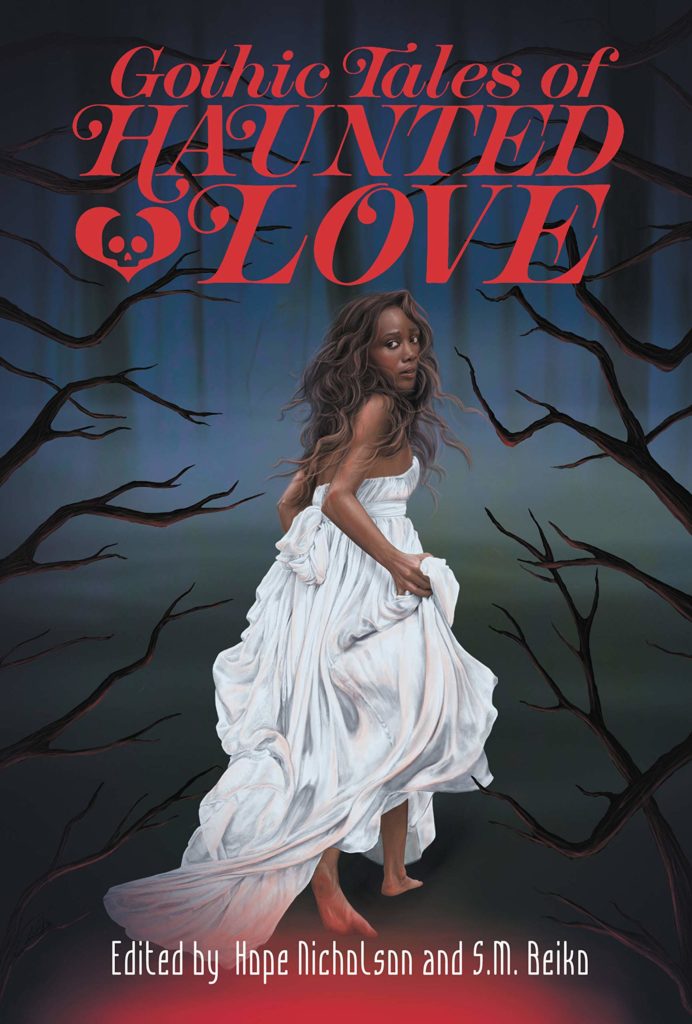
Gothic Tales of Haunted Love
Oh those poor unfortunate souls…
You remember the days of gloomy castles and shadowy mansions?
Your hair blowing in the night wind as you ran through the woods, branches snagging at your delicate white nightgown as you tried to escape the horrors of your new home?
Your ears trying to stay alert for the sounds of creaking stairs behind you as your curiosity overcame your senses and you were finally going to uncover his hidden secrets?
The way he held you in his strong arms and suddenly everything melted away in a sea of dark, unbridled passion?
Edited by Hope Nicholson and S.M. Beiko, published by Bedside Press, “Gothic Tales of Haunted Love” is a glorious salute to the forgotten gothic romance-horror comics of the 60s and 70s. Inspired by the likes of DC’s “Dark Mansion of Forbidden Love” and “The Sinister House of Secret Love,” “Gothic Tales” is a graphic novel anthology featuring tales of supernatural love in the past and present. Originally published through Kickstarter, I was one of the lucky backers who snagged a physical edition as my perk.
“Gothic Tales” features stories that don’t merely focus on heterosexual romance, but also include queer love stories (that don’t all necessarily end happily ever after). Some of the tales in this dark tome include:
- Crush: A young governess finds herself falling for the sea captain whose children she cares for, but why do all his lovers vanish?
- Secrets in the Silk: Set in 1970s Taiwan, a woman is plagued by bizarre nightmares on the eve of her interview with her favorite fashion designer.
- Minefield: Told entirely in Vietnamese, a ghost tries to protect his love and help him escape from cruel American soldiers.
- The Return: A Native woman is mauled and left for dead, but is then slowly healed back to life by two compassionate strangers. However, the woman’s lover rejects her after seeing her mutilated visage.
- Lovers’ Moon: Two suitors hope to win their object of affection’s hand while a mysterious beast plagues the countryside.
- What’s Best: A mother worries for her daughter’s happiness.
Every story has a different creative team, giving each tale a unique feel instead of rehashing the same “Haunted woman longs for tortured man” setting.
This is a definite recommendation for any of us who’ve read “Fear Street Sagas” and are longing for the queer representation those books sorely lacked. As a bonus, the trade even has a quiz to measure “How Grave Is Your Misfortune.”
As a sidenote, there’s currently a campaign to fund a follow-up collection, “Gothic Tales of Haunted Futures,” on Kickstarter.

kimmie66 by Aaron Alexovich
Telly Kade is an average girl living a not-so-average life in the average 23rd Century. Like most people of her time, Telly hangs out in a “Lair,” the term used to describe your run-of-the-mill virtual reality realm in the future’s advanced version of the internet. There are Lairs for everyone, tailored to every possible genre and experience. Historical Lairs, fighting Lairs, space exploration Lairs, and even furry Lairs. Telly’s Lair is “Elysium,” home to horror lovers du jor.
Telly is different from most people in that she’s not the most extreme Lair user out there. She doesn’t use a fancy handle and her avatar looks pretty much exactly like she does in the real world. Not like her two best friends in the whole world. First there’s Nekokat, who’s loud, overly dramatic, and honestly kind of rude. And then there’s Kimmie66, who’s probably the coolest, smartest person Telly’s ever met. Telly thinks Kimmie’s amazing, and Kimmie thinks extremely highly of Telly…
Which is probably why Telly’s the only one who received Kimmie’s suicide note.
“kimmie66” was published under Minx, DC’s first attempt at a Young Adult print back in the late 2000s. Written and drawn by Aaron Alexovich of “Invader Zim” and “Serenity Rose” fame, it’s the story of a girl who finds herself stuck in the middle of a conspiracy and a digital ghost story. While Telly tries to figure out if Kimmie’s suicide note is for real, she finds herself asking questions about the tenuous connections developed through V.R. usage. No, this isn’t an anti-internet story, but Telly does admit she’s bothered by the realization she doesn’t really know anything about her supposed friends beyond the backstories they’ve fabricated through the internet.
More information about Kimmie comes to light, and Telly discovers her friend was a “Drifter,” a person with multiple avatars throughout different Lairs which is largely considered taboo. This could explain why, despite the belief Kimmie’s dead, she keeps appearing in Elysium and in other Lairs. Or has she?
The closer Telly gets to learning what kind of person Kimmie WAS, she begins to learn the person Kimmie’s BECOME is dangerous, and the ramifications of her death might destroy their entire world.
What’s great about this story is Alexovich avoids displaying 23rd Century society’s usage of the internet as bad, showing the eventual evolution to V.R. surroundings as normal as us utilizing programs like tumblr and twitter are today. Granted it’s clear at least part of the story’s saying moderation is necessary.
Telly’s endearing for her self-awareness as a character, not making much of a big deal of how withdrawn she is and not viewing herself as better than anyone just because she doesn’t follow the hype. One part in particular that’s rather powerful is Telly saying it’s easy for us, the readers, to not understand why the Lairs are a big deal to people in her time and we don’t have the right to judge.
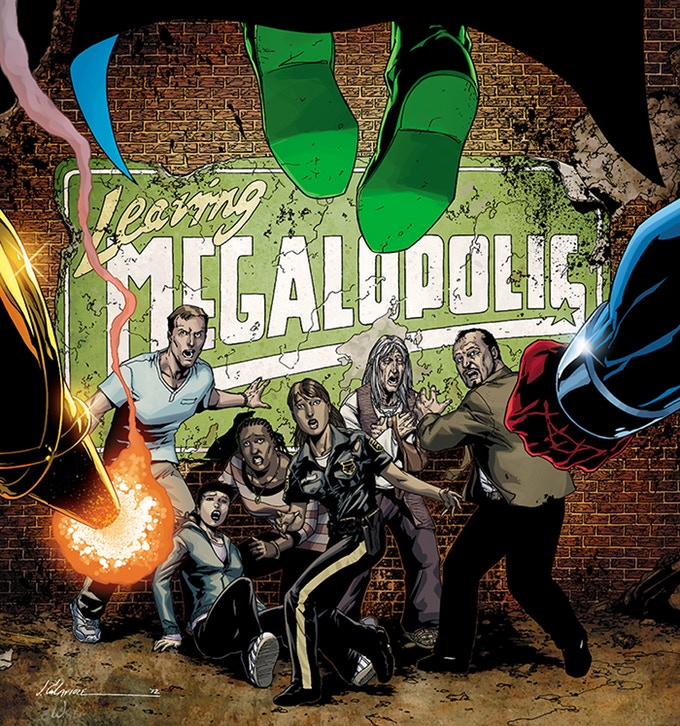
Leaving Megalopolis by Gail Simone and Jim Calafiore
It’s like “Justice League” but only if the Justice League was trying to murder everyone.
Megalopolis was considered the safest city in America because of its abundance of megaheroes. You had Overlord, Fleet, Southern Belle, the Mite Brigade, Cupid, the Red Flame, and many others. But then one day, after battling an extradimensional monstrosity in the heart of Megalopolis, something happened, and the heroes turned into unrelenting killing machines.
Now the city’s been quarantined by the army in the hope of making sure none of the heroes get out. That’s the thing though, because the heroes don’t WANT to leave… and they don’t want anyone else leaving either. What follows is a tale of an assorted group of survivors trying to navigate their way out of Megalopolis without getting murdered by their former protectors or by the desperate gang of apartment dwellers who’ve been offering human sacrifices to save their own asses.
Simone and Calafiore previously worked together on “Secret Six” from DC, back before everything went to Hell in 2011, and Simone’s at her best delivering her usual style of horrifically black comedy and terror alongside her band of endearing, well developed main characters and supremely fucked up super characters. Calafiore delivers an untold plethora of amazing character designs and impressively clear and detailed blood and gore. The original graphic novel received a follow up from Dark Horse Comics, “Surviving Megalopolis,” which answers a question many should’ve wondered in the first book: what happened to all the villains?
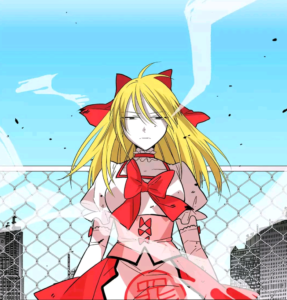
Miss Guillotine by Gaje and stego
The magical girls of Peace City are the reason why it’s so, um, peaceful. They risk their lives every day to fight monsters and alien invaders, and the citizens are incredibly grateful. In fact, the magical girls are super popular and have a number of endorsement and TV deals. In the eyes of the public, they can do no wrong. Especially Hailey, a.k.a. Illuminaty Beauty, currently THE most popular and beautiful magical girl of them all.
Unfortunately for everyone involved, most of Peace City’s magical girls, ESPECIALLY Hailey, are also horribly conceited, sadistic bullies who treat their classmates like garbage. The reason they get away with being so awful is because, hey, if they’re putting their lives on the line every day, then that means they’re in the right. If you oppose them or make life difficult for them, doesn’t that make YOU the bad guy?
Sisters Callie and Julie have recently run afoul of Hailey and her teammates, and Callie’s life is sheer misery because of Hailey’s bullying. One day, Julie is found dead under mysterious circumstances. The magical girls claim she was caught in the crossfire of a monster attack, but Callie realizes they’re lying when she notices their story doesn’t make sense. Immediately, Callie believes they killed Julie.
After disappearing for a year, Callie returns with a new look and starts calling herself “Julie.” Armed with a notebook her sister left behind detailing all the weaknesses of Hailey and her teammates, Callie’s going to get revenge for Julie’s death. She fashions the identity of “Guillotine” and plans to murder the magical girls one by one. Unfortunately, Callie’s going to discover Hailey wasn’t the worst of the magical girls and that Julie had a bigger connection to them than anyone could’ve ever suspected.
One of many recent “Dark Magical Girl” stories that have emerged due to the popularity of “Madoka Magica,” “Miss Guillotine” surprised me. Rather than going the route of saying all these girls were bad simply because they were magical girls, it explains there are a number of complicated reasons why they turned out as they did. Many of them weren’t qualified to be magical girls when they were chosen, or they were given abilities they weren’t suited to handle, which are interesting concepts to explore in the genre. What happens when the wrong person gets the wrong power?
“Miss Guillotine” discusses the very subjective natures of what we consider “Beauty” and “Justice,” examining them through the lenses of public perception, bullying, fame, and complacency. That’s not to say this isn’t a difficult read, especially regarding the method through which Hailey is taken down. This involves extensive fat shaming and humiliation. However, the comic’s not as dark or problematic as “Mahou Shoujo Site” since the narrative doesn’t shy away from pointing out Callie’s crossing the Moral Event Horizon to achieve her goals.
The artwork by stego’s especially enjoyable, given each magical girl receives their own distinctive appearance and design. My favorite of them all is Sarah, a.k.a. Platina Campanula, who stands as the one good (but not blameless) magical girl whose personal arc involves her struggling to find the courage to overcome her complacency and fear of making things worse if she gets involved.
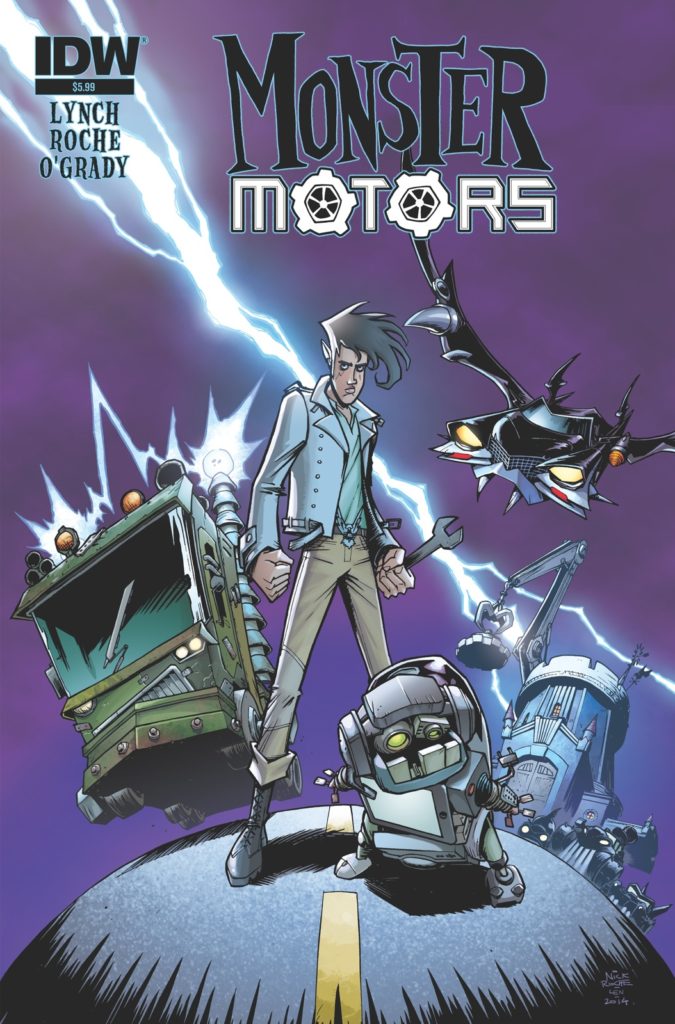
Monster Motors by Brian Lynch and Nick Roche
Victor Frankenstein is a genius scientist who has just moved to Transylvania. Transylvania, Kentucky that is. Having recently purchased a very large, fenced in junkyard, Victor plans to show all those fools at the Ingolstadt School for Automotive Repair how wrong they were to doubt his mechanical prowess. Unfortunately, Victor and his assistant iGor. realize too late the previous owners of the junkyard were trying very hard to keep something from getting OUT.
Something they’ve unwittingly awoken.
Something like the gas sucking fiend known as… CADILLACULA, THE VAMPIRE CAR!
Yes you read that right.
“Monster Motors” is another find from IDW, a hilarious pun fest of monsters and cars combined together. The trade features the original oneshot and the two-issue follow up, “The Curse of Minivan Helsing.” The opening story features Vic’s battle against the fiendish Cadillac and his efforts to create the powerful FRANKENRIDE to take the gas-addict down. The sequel story features April Van Helsing and her father, whose soul was transferred into a minivan. Together with their entourage of captured monster motors like LAGOON BUGGY and WHEELWOLF, the Van Helsings believe Vic and Frankenride are threats that need to be neutralized. Sadly, their battle leads to the creation of a horde of ZOOMBIES!
There’s not much to say other than this book deserves a look if you’re into creative puns and classic monsters.
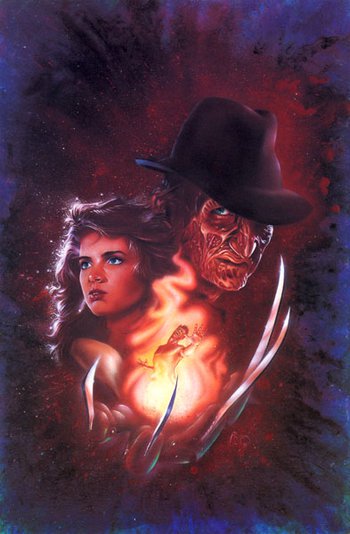
Nightmares on Elm Street by Andy Mangels
Innovation Comics was probably one of the more well known non-DC and Marvel comics companies of the 1980s. At least I think so. They closed at some point in the early 90s, though many of their creators are still active in the comic industry.
After Marvel lost the license to create “Elm Street” comics, Innovation picked it up and did several titles among its horror books. “Nightmares” is by far my favorite of all the comics published featuring the Elm Street cast. They’ve definitely aged better than the cringe worthy Avatar comics (which included one story where Freddy Krueger choked someone to death with BLING), and the boring Wildstorm comics (not even the “Freddy Vs. Jason. Vs. Ash” comics were particularly enjoyable for me).
“Nightmares” was a six issue series published around the time “Freddy’s Dead: The Final Nightmare” was being released. Innovation also did a three issue adaption of the movie, too. The series was split into two different story arcs.
- 1-2, featuring art by that transphobic shithead Tony Harris years before he worked with James Robinson on “Starman”
- 3-6, featuring art by Patrick Rolo which admittedly wasn’t as good as Harris’s stuff unfortunately
The first arc focused extensively on the original Elm Street heroine, Nancy Thompson. It filled in the gaps between Part One and Part Three by revealing what happened to Nancy immediately after the end of the original movie, and what happened after the end of “Dream Warriors.” Freddy’s attempting to hunt Nancy down through the dreams of her former college roommates, Sybil and Priscilla. Sybil’s a self styled “Ripperologist” whose nightmares are set in Victorian London, while Priscilla’s an openly gay woman and fledgling fashion designer who gets torn apart by a Freddy sewing machine.
Sigh, sadly, of course the only Elm Street story to feature openly queer characters (Priscilla and her girlfriend Max) has both of them gruesomely murdered. Though Max’s death is kind of vague; it’s not clear if Freddy actually murdered her or if that was part of Priscilla’s nightmare and the real Max is fine. Still, dead lesbian used for shock value eww.
The second arc’s an interquel taking place between “Dream Child” and “Freddy’s Dead.” Featuring the return of my favorite Elm Street heroine, Alice Johnson, #3-6 shows Springwood starting its transformation into the hellhole it would become by “Freddy’s Dead.” Alice returns with her young son Jacob to arrange her dad’s funeral, and is told there’s a new serial killer hunting people in the waking world. Oh, and this new killer is working for Freddy Krueger.
#3-6 is a continuity bonanza for Elm Street fans, and handles such a task far better than Wildstorm’s “Nightmare Warriors” did. I’ll never forgive what happened to Alice in that story.
The physical issues are extremely hard to find because they’re so expensive. It’s been nearly 20 years and I’ve only been able to purchase #1-3. You can, however, read them online.
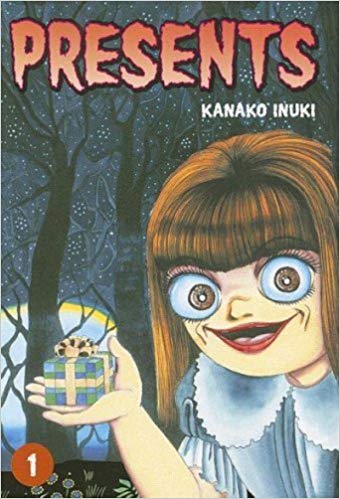
Presents by Kanako Inuki
Everyone hates getting older but they love getting presents on their birthdays, right? So, what if the reason why we get older on our birthdays is because time discovered a way to sneak past our defenses? What if, whenever we open our birthday gifts, there’s always a little bit of time hiding inside, attacking us when we least expect it and making us get older against our will?
That’s why Kurumi hasn’t aged, you see. It’s been so long since she was given a birthday gift, she’s remained a child for decades. In her wandering trying to find her birthday gifts, she’s become more than a human child. Kurumi has become a sort of spirit of presents, a trickster who comes to people when they need help, or deserve punishment, and gives out lessons about greed and kindness.
At first glance, you’d think “Presents” is a by the numbers “Someone gets gift, something bad happens” story, but it’s not. “Presents” is actually a very interesting look into the concepts of generosity and greed, and focuses more on why we give gifts to each other instead of the gifts themselves. The first volume includes stories about what we put into our presents when we make them, our feelings of love or resentment and betrayal. In one tale, a struggling artist tries to create a magnificent portrait of a gallery owner’s daughter, and Kurumi tells him the reason his paintings fail is because none of them contain the feelings he experienced when he saw the woman for the first time. In another, a greedy young girl likes to send away for free prizes from companies, smugly thinking she’s got it all worked out but ends up the unwitting guinea pig of a cosmetics corporation.
Kanako Inuki does a terrific job of freaking out readers, with her blend of drawing cute young girls in frilly dresses while subjecting them through horrific transformations and mutilations. Kurumi is a rather endearing main character from her even mix of trollish delight in watching people suffer to her genuine desire to help those in need. When dealing with a young girl who’s been mutilated by her supposed best friend, Kurumi realizes said girl genuinely is as naive as she appears to be and only confirms it’s the right thing to help her.
Kurumi’s also shown to be fallible. In one particularly memorable and gruesome story, Kurumi’s innocent white lie to a neglected young girl ends up having horrifying consequences for all involved. But at the end of the day, all Kurumi wants to do is find her presents so she can grow up.
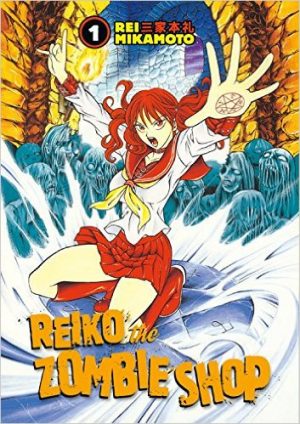
Reiko the Zombie Shop by Rei Mikamoto
Hello friends! Has the following ever happened to you?
- Your daughter commits suicide and doesn’t leave a note explaining why?
- You have to stay late after school, only to find one of your friends dead on the stairs and you’re being accused of killing her?
- You’re a mega rock star with months to live and you’re afraid you might croak on stage at your biggest concert?
- You need help figuring out who has gruesomely murdered over thirty little girls in your supposedly quiet town?
Well then you need Reiko Himezono, a.k.a. Reiko the Zombie Shop! She’ll raise the dead, expose long buried secrets, and help the living get closure.
WARNING REIKO IS NOT LIABLE FOR THE DEAD GOING ON A BRUTAL RAMPAGE TO GET REVENGE AGAINST THE ONES WHO KILLED THEM
WARNING DO NOT WEAR WHITE CLOTHING WHILE HIRING REIKO AS YOU *WILL* GET WET
PAYMENT UP FRONT
NO DISCOUNTS
In case you haven’t figured it out, Reiko Himezono’s a teen necromancer for hire. Armed with the ability to summon the dead back to life, Reiko offers her services to those wishing to air their grievances, find closure, or stop more deaths from happening. As such, she’s also made a lot of enemies and many of them are summoners as well.
I first mentioned “Reiko the Zombie Shop” in my NYCC ’18 sketch post but I never recapped the series. I purchased the first volume in high school but it was so much more bloodier and graphic than I was expecting, I lost my taste for a few years. Rei Mikamoto, the writer and artist, doesn’t hold back in the gore category regardless of age or gender. This is especially prevalent in the “Dead Sister” side stories, following a serial killer with a little sister complex. Mikamoto does NOT leave anything to our imaginations.
The first book is fairly formulaic, wherein Reiko is asked by some individual or group to revive a person and things go horribly wrong because that person died violently and THEY HAVE ISSUES. Reiko always warns her customers these things will happen especially if the guilty party is present at the summoning, but they never listen.
The second volume’s got Mikamoto doing world building, where other summoners are introduced and the tone goes into an action horror type of scenario. We learn summoners are capable of bringing forth their own personal zombie to fight for them, and these zombies can range from humans, animals, even DINOSAURS. It introduces an overreaching arc involving Reiko’s battle with someone from her past who intends to use their summoning abilities to take over the world.
The third volume onward’s a mix between the main arc and a return to the formula of Reiko getting hired, plus some one-shot stories that have nothing to do with Reiko’s world. Too bad Dark Horse stopped translating after the sixth book.
Reiko as a protagonist is interesting because she’s only in it for the money. She’s calm, collected, and professional. If she gets freaked out, it means things are gonna get FUCKED UP. Reiko has a strong sense of business ethics and never reneges on her contracts, but she’ll break a deal and leave her customers to their messes if it turns out they’ve withheld information or violated the terms of agreement in any way. Reiko’s cold, but she’s not heartless or apathetic, and the best part’s there’s no useless male love interest to mess up the story!


